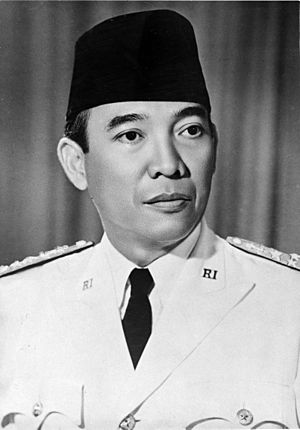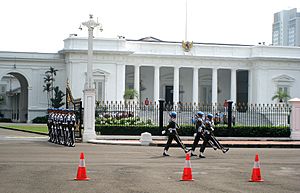President of Indonesia facts for kids
The President of Indonesia is the country's leader, acting as both the head of state and the head of government. This means the president is in charge of the Indonesian government and is also the top commander of the Indonesian National Armed Forces and the Indonesian National Police. Since 2004, the president and vice president are chosen directly by the people for a five-year term. They can serve for a maximum of two terms, which means up to ten years in office.
The current president is Prabowo Subianto, who started his term on 20 October 2024.
Quick facts for kids President of the Republic of Indonesia |
|
|---|---|

Presidential seal
|
|
|
|
| Style |
|
| Member of | Cabinet |
| Residence |
|
| Seat | Jakarta |
| Appointer | Direct popular election |
| Term length | Five years,
renewable once
|
| Constituting instrument | Constitution of Indonesia |
| Precursor | Governor-General of the Dutch East Indies |
| Inaugural holder | Sukarno |
| Formation | 18 August 1945 |
| Deputy | Vice President |
| Salary | Rp 62,657,809/US$ 4,379 per month |

Contents
History of the Presidency
Early Days: Sukarno's Leadership
The idea of a president for Indonesia began when the 1945 Constitution was being written. The first president, Sukarno, was chosen on 18 August 1945. This happened because the group that was supposed to elect the president, the People's Consultative Assembly (MPR), had not yet been formed.
At first, the president's role was mostly ceremonial, like a symbol for the country. The prime minister was in charge of the government. However, Sukarno wanted more power. He introduced a system called "Guided Democracy" in the 1950s. This system aimed for decisions to be made with the president's guidance.
In 1959, Sukarno brought back the 1945 Constitution. This change made the president both the head of state and the head of government. In 1963, Sukarno was even elected president for life. But by 1967, political changes led to Sukarno stepping down. Suharto, an Army Chief of Staff, then became the acting president.
Suharto's Long Rule
Suharto was elected president in 1968. He ruled for a long time, making sure the MPR and other government bodies followed his lead. He had a lot of power, often making laws himself. For most of his time in office, Suharto controlled almost all government decisions.
Changes After Suharto: The Reform Era
After Suharto left office on 21 May 1998, big changes happened. The presidency became more balanced. For example, B. J. Habibie, who followed Suharto, had his report to the MPR rejected. This showed that the MPR now had more power to check the president.
Abdurrahman Wahid was the first president who had to win an election against other candidates. He was also the first to be chosen by counting votes, not just by agreement. However, Wahid was later removed from office by the MPR. This was another clear sign that the MPR could now limit the president's power. His vice-president, Megawati Sukarnoputri, then took over.
In 2001, the constitution was changed again. This time, it was decided that starting in 2004, the president would be elected directly by the people. To prevent any president from becoming too powerful, new rules were added. For instance, a president can only serve two terms. They also lost the power to create laws on their own, but they could suggest new laws.
In the 2004 Indonesian presidential election, Susilo Bambang Yudhoyono became Indonesia's first directly elected president. He won against Megawati Sukarnoputri. He was re-elected in 2009. After serving two terms, he could not run again.
The 2014 Indonesian presidential election saw Joko Widodo win against Prabowo Subianto. Joko Widodo and his vice-president, Jusuf Kalla, started their five-year term on 20 October 2014.
Who Can Be President?
To become president, a person must meet certain requirements. These rules are set by the 1945 Constitution and other laws.
Here are some key requirements:
- They must be an Indonesian citizen since birth and not have citizenship in any other country.
- They must be physically and mentally able to do the job.
- They must not have betrayed the country or been involved in serious crimes like corruption.
- They need to be at least 40 years old.
- They must have at least a high school diploma.
- They must be loyal to Pancasila (Indonesia's state philosophy), the 1945 Constitution, and the country's motto, Bhinneka Tunggal Ika (Unity in Diversity).
- They cannot have served as president for two terms already.
- They must be nominated by a political party or a group of political parties.
How the President is Elected and Serves
The president and vice president are elected together by the people. They run as a team. To win, they need more than half of all votes across the country. They also need at least 20% of the votes in at least half of Indonesia's provinces. If no team wins outright in the first round, the top two teams have a second election (a runoff). The team with the most votes in the runoff wins.
Once elected, the president and vice president serve for five years. They can be re-elected only once, for a total of ten years. Before starting their job, they must take an oath or make a promise to serve the country.
Presidential Oath
Before taking office, the president or vice president must take an oath or make a promise. This usually happens in a meeting of the People's Consultative Assembly (MPR).
Here is the oath: "I swear by God to fulfill the duties of President (Vice President) of the Republic of Indonesia to the best of my capabilities and in the fairest way possible, to uphold the Constitution by all means and to execute all laws and regulations as straightforwardly as possible as well as to dedicate myself to the service of the Nation and the People."
What the President Does
The president has many important powers:
- They lead the government and can choose or remove ministers who help run different parts of the government.
- They can suggest new laws to the DPR (the main law-making body) and work with the DPR to agree on laws.
- In emergencies, they can make special government rules that act like laws.
- The president is the supreme commander of the Indonesian National Armed Forces.
- They can sign treaties with other countries, but often need the DPR's agreement.
- They appoint ambassadors to other countries and welcome ambassadors from other nations.
- The president can grant pardons to people, but they must consider advice from the Supreme Court.
Help for the President
The president gets help from the vice president and their ministers. Each minister is in charge of a specific area, like education or health. The president can also create special teams to give them advice.
What Happens if a President Cannot Serve?
If the president dies, resigns, is removed from office, or cannot do their job, the vice president takes over.
If both the president and vice president cannot serve, then the Minister of Home Affairs, Minister of Foreign Affairs, and Minister of Defense temporarily take charge together. The MPR must then elect a new president and vice president within 30 days.
A president or vice president can be removed from office if they break the law, for example, by committing treason, corruption, or other serious crimes. The DPR can ask the Constitutional Court to investigate. If the court agrees, the DPR can then ask the MPR to vote on removing the president.
Life After the Presidency
After their term ends, former presidents receive a pension. They are also given a house, with the government covering electricity, water, and phone bills. They get free healthcare for their families and a car with a driver.
Presidential Awards
As the highest leader, the president automatically receives the highest awards and honors in Indonesia. These include various "Star Decorations" for service to the country, military, and police.
List of Presidents
Timeline of Presidents

Presidents During the Revolution
During the Indonesian National Revolution, Indonesia had several leaders:
- Sukarno (18 August 1945 – 18 December 1948)
- Sjafruddin Prawiranegara (19 December 1948 – 13 July 1949) – He led an emergency government.
- Sukarno (13 July 1949 – 17 December 1949)
- Assaat (17 December 1949 – 15 August 1950) – He was president of the Republic of Indonesia when it was part of a larger union called the United States of Indonesia.
- Sukarno (from 15 August 1950) – He became president again when Indonesia became a single, unified country.
Latest Election Results
The most recent presidential election happened in 2024. In this election, Prabowo Subianto and his running mate Gibran Rakabuming Raka won with 58.6% of the votes. They defeated other candidates like Anies Baswedan and Ganjar Pranowo.
See also




